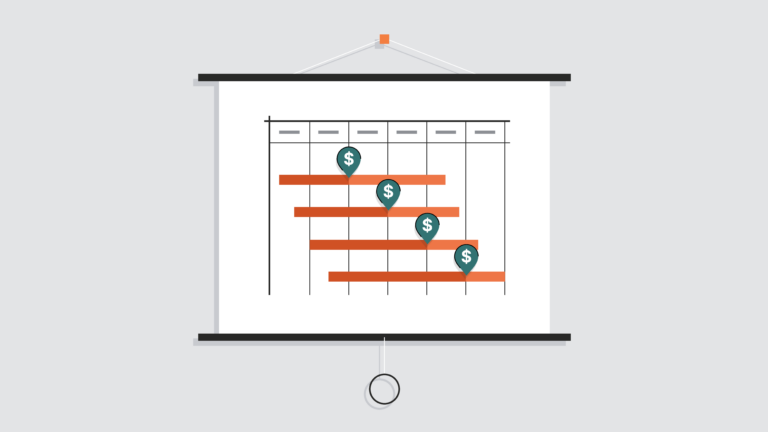

There are lots of ways to bill for work on a construction project. You can bill at the end of the project, at the beginning, or as you go along. Progress payments are made while the project is ongoing, and they are made as a result of progress billing. In this article, we’ll look at what progress payments are, some pros and cons, and how retainage affects progress payments.
Table of contents
Simply put, progress payments are based on the percentage of the work that is complete. Instead of waiting until the end of the job to bill, with progress billing, it is possible to bill incrementally as the job goes along. Typically, payments are made on a monthly schedule, but they may also be sent at certain percentages of completion (e.g. when the job is 30% complete, 60% complete, and 100% complete).
There are several different construction contract pricing structures. Some of the more common are:
Unit priceTime and material contracts (T&M) are based on the actual hours worked and the materials purchased for the job during the time you are billing for. Usually, an hourly billing rate is agreed upon, and there is a set markup for the materials. Invoice amounts are a simple math equation (labor hours x labor rate + materials costs x mark-up percentage). It is important to keep good records of costs, as owners or general contractors may want to review them to make sure they are getting what they are paying for.
On lump sum contracts, the contract price is a set amount. This type of contract is generally used when the total costs for the project can be easily estimated. On a small project, a subcontractor may bill with a simple invoice at the end of the project. They are very easy to prepare and usually, there isn’t much back-up documentation required. On a larger project, lump sum contracts may call for progress billing to give the owner more control over the work as it progresses, and provide ongoing payments to the subcontractor doing the work.
Cost-plus contracts work like T&M, in that they use the actual construction costs as the basis for the total contract price. In these contracts, the subcontractor adds a percentage or set fee to the contract cost of the project for overhead or other expenses. The owner or GC may require backup documentation so they can verify expenses.
Under a unit price contract, the price for a unit of work is set ahead of time (say $100 per linear foot), and that amount is multiplied by the number of units complete. This is straightforward, except when there are disagreements about how many units are complete. The subcontractor may need to show documentation that proves the amount of work completed.
Free educational courses on Health & Safety, Data in Construction, and more. Earn Your Continuing Education Units (CEUs) for license renewals and career advancement with Procore.
![]()
Some of these contract structures can be combined with progress payments, such as lump sum or cost-plus contracts. The key to understanding progress payments is remembering that the portion of work completed to date is used to determine how much to bill.
Contractors or subcontractors can request a progress payment using a payment application, which should be defined in the contract requirements. A payment application is a type of construction document that prime contractors and first-tier subcontractors use to request payment from the hiring party.
Filling out a pay application correctly will generally require a clear schedule of values, or SOV. The SOV contains a line-item list of all of the work you will complete on the job, and the value of each item. The scope of work in the contract is the basis for the schedule of values.
Two of the most common standardized payment applications for subcontractors are the AIA G702 and ConsensusDocs 710. Both allow for progress billing, or you can create your own. The contract should give you guidance on what type of pay application is acceptable.
Subcontractors or prime contractors using progress billing should submit their applications to the hiring party according to the contract timeline. It may be on a monthly basis, or when a certain percentage of the work is completed. Again — look to the contract for guidance on timing.
Progress payments provide benefits to everyone up and down the payment chain. They allow owners and/or prime contractors to review the subcontractors' work before it's complete, and resolve disputes before the project is over.
For subcontractors, one of the best reasons to use progress payments is that you don’t have to wait until the end of the job for payment. A regular payment schedule makes it easier to predict and control cash flow. It is especially helpful for small businesses that don't have large cash reserves to wait for lump-sum payments.
Subcontractors can pay expenses on a job as they go. If you have cash flowing in throughout the project, then you can pay your employees and bills on time. You don’t have to wait until the end to pay everyone (if they’ll even let you wait that long), and you're less likely to go into debt to make ends meet.
Also, if you are billing as you go, it will be easier to spot a payment problem. For example, if the first couple of payments are really prompt, and then they start to take longer and longer as you go along, it could be a red flag that the project is experiencing financial issues. If you wait until the end of the project, you won’t know whether the owner has the money set aside or not. By that time, it is too late, and your only remedies may be filing a mechanics lien or pursuing a lawsuit.
If there is a payment issue and you are billing as you go, you can stop the work until the payment issue is resolved. Many contracts stipulate your ability to do this to resolve disputes. Using this tactic is very effective in securing payment. Owners don’t want their projects delayed for any reason, even if it is their own lack of payment. And if it is a GC that isn’t paying you, stopping work will get the owner’s attention quickly.
Subscribe to Blueprint, Procore’s free construction newsletter, to get content from industry experts delivered straight to your inbox.

The main drawback to progress billings is time. It can take time to put together a payment application multiple times during a project. Some projects may only take a few minutes to invoice, but others, depending on the payment application requirements, can take significantly longer. If you must collect lien waivers or other documentation from suppliers and sub-subs, it can be difficult and confusing. It is tempting to wait until the end of the job and only submit one invoice, but on larger projects, this often isn’t financially feasible. You just have to bite the bullet and take the time each month to put together your progress billings.
There are a couple of things you can do to speed up the billing process. One is to establish a billing process. Make a checklist of documents you need for your payment application each month, and who is responsible for collecting each one. This way everyone knows what they must do. Then, set deadlines to make sure each person completes their task in time. You can speed up the payment application process with an effective document retention strategy.
Keep all the reports and information you need for invoicing in an organized space so you can easily find them. If you have to hunt everywhere for timecards, receipts, and cost reports, you’ll get frustrated and things will take twice as long. Staying organized is the key.
Another drawback to progress billings is that there can be disputes about how much of the work has actually been completed. The general contractor or owner may want to cut your invoice down because they think you’re only 40% complete when you billed for 50%. This can hurt your cash flow. It can be tempting to overbill for your work to compensate for this. Be careful, as projects will likely require proof of work completed. In addition, overbilling can hurt you later on when you have expenses you can’t cover.
Retainage is money that the hiring party withholds from payment to assure that work complete and of high quality. It's also known as retention. When the contract includes retainage, the owner or GC generally withholds 5-10% of the dollar amount from each progress payment. This practice often flows down to subcontractors and even sub-subcontractors. The hiring party should make a retainage payment at the end, when all punch-list items are complete and the sub has turned in all required documents.
Some contracts allow contractors to apply for a partial retention payment before they finish completely. Sometimes, the contract terms may change retainage policy once the project is half complete. At that point, the subcontractor can apply for half the retention due at that time. This recognizes the fact that contractors that are on the site early, like those performing site work and concrete, have already completed their work and can’t address any issues once the building starts going up. So, instead of having to wait months or years until the project is complete, they can often recover retainage early.
Overall, progress payments can be good for everyone on the construction project.
For owners and prime contractors, progress billing allows them to see subcontractors' progress clearly. Applications for progress payments can bring quality or work issues to light before they become a bigger problem.
Progress billing gives more control to subcontractors as well. It allows them to get paid on a regular schedule as they complete their work. Progress payments help control cash flow and can allow contractors to pay employees and suppliers on time. While putting payment applications together can be time-consuming at first, establishing a regular process makes the work easier.